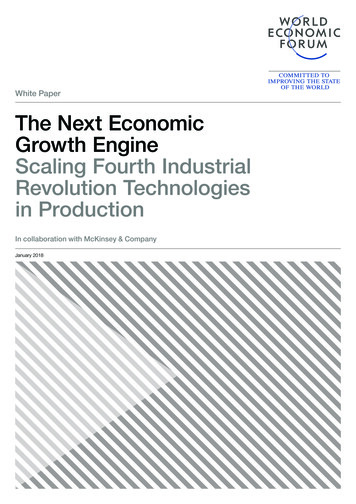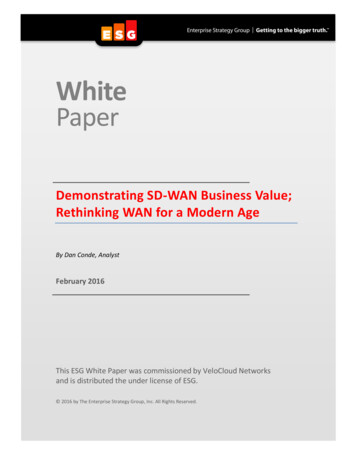
Transcription
White PaperThe Next EconomicGrowth EngineScaling Fourth IndustrialRevolution Technologiesin ProductionIn collaboration with McKinsey & CompanyJanuary 2018
ContentsForeword 3Executive summary 41. Technology is shaping the future of production52. Escaping from pilot purgatory in the FourthIndustrial Revolution 73. Accelerating adoption of Fourth Industrial Revolutiontechnologies: recommendations for business leaders93.1 The value delivery engine – high-impact use cases103.2 The scale-up engine – actionable best practices164. Diffusing strategies: recommendations for country leaders195. Building opportunities for public-private collaboration atthe World Economic Forum22Annex 1: Value delivery engine – Use-case library24Annex 2: Scale-up engine27Endnotes 30Acknowledgements 31 World Economic Forum2018 – All rights reservedNo part of this publication may be reproduced ortransmitted in any form or by any means, includingphotocopying and recording, or by any informationstorage and retrieval system.The views expressed are those of certain participants inthe discussion, and do not necessarily reflect the views ofall participants or of the World Economic Forum.REF 110118 - case 00039546
ForewordAfter a decade of stagnated productivity, the Fourth Industrial Revolution isexpected to create up to 3.7 trillion in value by 2025. Technologies such asthe internet of things, advanced robotics, artificial intelligence and additivemanufacturing are already helping to generate net productivity increases.However, to achieve the desired broad-based economic and societal impactand to maximize productivity benefits, technology must be adopted atscale and diffused throughout the ecosystem. This requires strengthenedcollaboration between governments, businesses, academia and civil society,thus unlocking the full value delivered to the economy and society.Helena LeurentHead of Future ofProduction SystemInitiativeMember of theExecutive CommitteeWorld EconomicForumEnno de BoerPartner, McKinsey &Company, USAThe World Economic Forum System Initiative on Shaping the Future ofProduction provides a platform for leaders across the public and privatesectors to work together to build a more inclusive and sustainable future ofproduction. In pursuing this, they look to technology and innovation to boosteconomic growth, and to promote a human-centred approach for the benefitof all. Established in 2016, the System Initiative’s community has become morediverse and counts over 60 businesses from 18 industry sectors, 25 ministersof commerce and/or industry, and representatives from top engineeringuniversities, labour unions and civil society organizations.Within the System Initiative’s framework, the Technology and Innovation forthe Future of Production project, developed in collaboration with McKinsey& Company, is exploring how industrial companies can take technologyadoption in production from proof of concept to industrial scale. The projectis also examining how governments and civil society can best support thedevelopment of a favourable ecosystem for adopting and diffusing technologyacross industry sectors.This White Paper summarizes new findings, conclusions and recommendationsfor governments and businesses, drawn from desk research and extensiveconsultations from May to November 2017. The goal is to inform the design offuture strategies for the adoption and diffusion of Fourth Industrial Revolutiontechnologies at scale through strengthened public-private collaboration.The Next Economic Growth Engine3
Executive summaryWith the advent of the Fourth Industrial Revolution,countries and companies have an opportunity to counterand potentially reverse the slowdown in productivityby diffusing and adopting technology at scale. In fastevolving and converging technologies for production,accelerated growth and maturity are occurring like neverbefore. The latest developments of the internet of things(IoT) allow for connecting and tracking asset performancein real time, as well as for integrating production andconsumption processes. Artificial intelligence, which since2015 has achieved image and speech recognition at thelevel of the human brain, can process large amounts ofdata that factories collect to increase efficiencies andinform accurate decision-making. Advanced robotsand computers can perform a range of routine physicalactivities and increasingly accomplish activities requiringcognitive capabilities, such as tacit judgements or sensingemotions. According to the McKinsey Global Institute, morethan 60% of all manufacturing activities can be automatedwith current automation technology.1,2These changes are driving the world towards a future ofproduction characterized by autonomous, self-organizingfactories and integrated or hyperconnected productionsystems. Manufacturing companies, suppliers andcustomers will ultimately be connected on a common IoTplatform. Technology will empower the factory worker andplant manager, with a third of tasks almost fully automated,thus shifting the focus from execution of repetitive andinefficient tasks to innovation. Technologies of the FourthIndustrial Revolution will generate inclusive growth andbring benefits beyond the factory’s four walls. They willpotentially deliver up to 3.7 trillion in value3 for the globaleconomy, offering new products and services to societyand supporting the environment by optimizing resourceconsumption.However, technology’s full potential for production, whenadopted at scale, is still far from being exploited. Whileseveral pioneering companies and early adopters praisetechnology’s positive impact, adoption remains slowand limited across all industry sectors. More than 70%of industrial companies are still either at the start of thejourney or unable to go beyond the pilot stage.4 Most arestuck in “pilot purgatory”, where technology is deployedexperimentally at reduced scale for an extended perioddue to the inability or lack of conviction to roll it out atproduction-system scale. Pilot purgatory occurs acrossindustries and countries, including the most advanced ofthem, with challenges compounded for small and mediumsized enterprises (SMEs).4The Next Economic Growth EngineTo maximize the potential gains in productivity brought bytechnology, companies must move from pilots to adoptingtechnology at scale, across multiple production facilitiesand through relevant value chains. They also must taketheir suppliers (often SMEs) and customers with them tobe able to innovate and transform their businesses models.Governments need to develop the right set of policies andprotocols to facilitate the dissemination and adoption oftechnology at the national level. Moreover, internationalcooperation and public-private partnerships must help toelevate productivity so that it benefits the global economy.Through its work in 2017, the Technology and Innovationfor the Future of Production project has generated newinsights and actionable recommendations for companiesand governments to accelerate the adoption and diffusionof technology at scale.The findings, conclusions and recommendations in thisWhite Paper are based on structured interviews withselect leaders and experts from the public and privatesectors, academia and civil society. In addition, the WorldEconomic Forum leveraged insights from McKinsey &Company’s technological network of partners; its annualDigital Manufacturing Global Expert Survey, with responsesfrom over 400 experts; and the latest IoT Pulse Survey,with responses from over 300 business leaders. Theinsights and recommendations in this White Paper will bepresented and discussed at the World Economic ForumAnnual Meeting 2018 in Davos-Klosters, Switzerland, andused to define key public-private collaborative interventionsneeded to accelerate technology diffusion acrossindustries and geographies.
1. Technology is shaping the futureof productionDespite the recent slowdown in global growth, productioncontinues to be a critical driver of the economy indeveloped and developing countries. It is the main sourceof investment in research, development and innovation(R&D&I), with manufacturing companies responsible formore than 85% of the R&D carried out by the private sectorin Germany, Japan and South Korea.5Technology and innovation have been and will remaincentral to how production evolves and is transformed. Overthe past 20 years, worker productivity across industriesin the United States increased by 47%,6 driven primarilyby technology adoption and innovation. Society is at thejuncture of the increasing convergence of production andconsumption, which is mainly driven by new businessmodels enabled by transformations in technology. In thecontext of the Fourth Industrial Revolution, production is atthe cusp of a paradigm shift driven by three technologicalmegatrends that have reached unprecedented pace andbreadth (Figure 1), even as their full-scale adoption andbenefits in production is yet to be realized.1.Connectivity: Rapidly expanding through the internetof things (IoT), connectivity has reached global scale,with 8.4 billion devices connected.7 As of today, only15% of assets are connected in production, but that ischanging rapidly. The technology industry is workingon more than 700 IoT platforms8 for industrial use, andmajor technology companies are investing heavily inhyperscalable IoT platforms.2. Intelligence: Artificial intelligence, advances incomputing power and the availability of big data areallowing machine learning algorithms to excel. In fact,speech and image recognition have already reachedthe accuracy of the human brain. The full potential ofartificial intelligence in production is however, yet to berealized; only a small fraction of data is currently usedfor decision-making. For example, on an oil rig, theresearch found that while 100% of data was captured,only 0.5% was used to make decisions.3. Flexible automation: Automation technology cancurrently automate 60% of all manufacturing tasks.9However, the current level of penetration of industrialrobots is still comparatively low, even in leadingadopters such as South Korea, where only 530 robotsper 10,000 production workers are deployed.10aFigure 1: Key technology megatrends transforming productionConnectivityCreates links betweendiscrete network nodes,increasing visibilityIntelligenceAutomates eventrecognition andtranslation sponsemechanisms,automation andremote movementSource: McKinsey & CompanyThe Next Economic Growth Engine5
The combined advances in connectivity, intelligenceand flexible automation will dramatically transform valuegeneration in production, as illustrated in Figure 2.(Production is defined as the end-to-end activities leadingto the realization of products and related services, in thecycle of me-service-end of use.) Four main, radical shifts areexpected in the short to medium term:1.Manufacturing will become self-organizing and moreautonomous due to a new class of factory workers or ahighly connected and smart shop floor2. Value chains will be seamlessly connected end to end,allowing manufacturers to drive product innovationtwice as fast as today3. Supply chains will connect to a broader supplierecosystem that will function as a single platform,enabling business-to-business integration4. Data will drive the creation of new services andinnovations in business modelsCustomers, employees and society will benefit from theseshifts. Customers will have access to products bettertailored to their needs; producers will easily capturetheir preferences and behaviours and input these tocustomize design and fabrication. Logistics companies, forexample, have changed their business model and enteredmanufacturing by incorporating on-demand 3D printedproducts in their range of services. For example, SAP haspartnered with UPS and Fast Radius on an integrated endto-end system for on-demand 3D printing.10b Manufacturingand product delivery times will be shortened, thanksnot only to developments in mobility but also to moreinterconnected and transparent supply chains, which willbe enhanced by process automation. Factories will bereshaped, and workers’ capabilities will be strengthenedby shifting the focus from execution of repetitive tasks toinnovation, in a much safer environment. The environmentwill benefit from increased efficiency in resourcemanagement as technology demonstrates its capacityto reduce energy consumption and material waste. TheAccelerating Sustainable Production project of the WorldEconomic Forum System Initiative on Shaping the Futureof Production describes a new set of public-private,technology-driven interventions to contribute towardsachieving the United Nations Sustainable DevelopmentGoals.Figure 2: Key shifts in production driven by Fourth Industrial Revolution technologies12AutonomousmanufacturingSeamless connectionof value chains34Connection of supplyNew value-addedservices and businesschains to suppliermodel innovationsecosystemSource: McKinsey & Company“We need to fully leverage digital and technological advancements to be able to predict and capture consumerdemand, and connect it seamlessly through production operations and materials sourcing. This will requirereskilling and empowering our workforce to harness the new forces of technology. When doing this responsibly,we create value across the supply chain using resources sustainably and helping our surrounding communitiesto prosper.”Mohamed Samir, President, India, Middle East and Africa, Procter & Gamble, United Arab Emirates6The Next Economic Growth Engine
2. Escaping from pilot purgatory in theFourth Industrial RevolutionBased on the research, technologies of the FourthIndustrial Revolution are showing positive returns andnew opportunities for growth. Nevertheless, the adoptionof technology in production still remains slow acrossind
28.09.2017 · 3.1 The value delivery engine – high-impact use cases 10 3.2 The scale-up engine – actionable best practices 16 4. Diffusing strategies: recommendations for country leaders 19 5. Building opportunities for public-private collaboration at the World Economic Forum 22 Annex 1: Value delivery engine – Use-case library 24 Annex 2: Scale-up engine 27 Endnotes30 Acknowledgements31 . The











